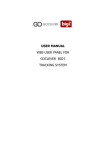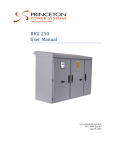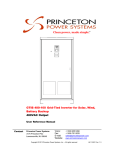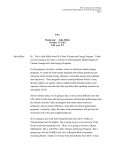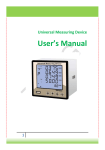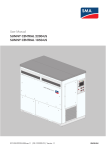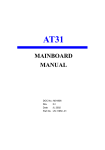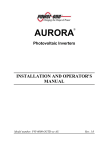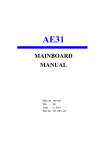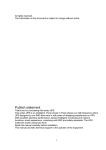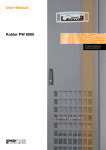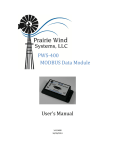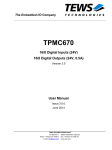Download BIGI-250 Installation Manual
Transcript
Clean power made simple.™ BIGI 250 Installation Manual www.princetonpower.com 4411-0008, Rev 0.5 June 25th 2013 This page intentionally left blank. About this Manual Copyright © Copyright 2013 Princeton Power Systems, Inc. 3175 Princeton Pike Lawrenceville, NJ 08648 Tel: 609-955-5390 Fax: 609-751-9225 Email: [email protected] Princeton Power Systems, Inc. and "Clean Power made simple" are registered trademarks of Princeton Power Systems, Inc. Specifications and descriptions in this document were in effect at the time of publication. Princeton Power Systems, Inc. reserves the right to change specifications, product appearance or to discontinue products at any time. No patent infringement liability is assumed by Princeton Power Systems, Inc. with regards to the use of information, circuits, equipment, or software described in this manual. The statements and information in this document must not be changed without special notification from Princeton Power Systems, Inc. Furthermore, Princeton Power Systems, Inc. does not commit to any further obligations with this document. Use and reproduction is only permitted in accordance with the contractual agreements with Princeton Power Systems, Inc. Under no circumstances may parts of this publication be copied, reproduced, stored in a retrieval system or translated into another language, except with written permission from Princeton Power Systems, Inc. 4411-0008, Rev 0.5 iii About this Manual About This Manual Purpose The purpose of this Installation Manual is to provide explanations and procedures for installing and troubleshooting the BIGI 250. Scope The manual provides safety guidelines, detailed planning and setup information, procedures for installing the inverter, as well as information about troubleshooting the unit. It does not provide details about particular brands of batteries. You need to consult individual battery manufacturers for this information. Audience The manual is intended for anyone who needs to install the BIGI 250. Installers should be certified technicians or electricians. iv 4411-0008, Rev 0.5 About this Manual Organization This manual is organized into three chapters and three appendices. Chapter 1, “System Overview” provides general information of the BIGI-250. Chapter 2, “Installation” describes how to mount and install the BIGI-250. Chapter 3, “Wiring Instructions” describes system configurations and how to perform wiring and cabling procedures. Appendix A, “BIGI-250 Specifications” provides the electrical and environmental specifications of the BIGI-250. Appendix B, "BIGI-250 Grounding” provides grounding method for various configurations. Appendix C, “BIGI-250 Default Trip Settings” Abbreviations and Definitions The following table provides a glossary of terms used in this manual. Abbreviations Definition AC Alternating Current BIGI Battery Integrated Grid Interactive CEC California Energy Commission DC Direct Current DRI Demand Response Inverter ESD Electro-Static Discharge GFDI Ground Fault Detector and Interrupter HMI Human/Machine Interface IEEE Institute of Electrical and Electronics Engineers MPPT Maximum Power Point Tracking NEC National Electrical Code PPS Princeton Power Systems, Inc. PV Photovoltaic THD Total Harmonic Distortion UL Underwriters Laboratories 4411-0008, Rev 0.5 v About this Manual Important Safety Instructions SAVE THESE INSTRUCTIONS– This manual contains important instructions for the BIGI-250 that shall be followed during installation and maintenance of the inverter. Symbols The following is a list of symbols used in this manual and on labels in the BIGI-250. DC circuit AC circuit Phase indicator Protective earth ground. Other grounding conductor. Warning Symbols Used in This Manual Attention: This symbol identifies information about circumstances or practices that could lead to personal injury, death, internal component damage, reduced product life, equipment damage, economic loss, or other adverse effects. Electric Shock Hazard: This symbol identifies information about a condition or procedure that could be potentially lethal or harmful to personnel or damaging to components due to live voltages within the system, components holding stored energy, or electrostatic discharge (ESD). vi 4411-0008, Rev 0.5 About this Manual Terms of Use Because of the wide variety of uses for power electronics equipment, this manual does not describe every possible application or configuration. All technicians responsible for installing, commissioning, and operating this equipment must satisfy themselves of the suitability and proper implementation of the intended application of this power conversion product. In no event will PPS, its subsidiaries, partners, employees, or affiliates be responsible or liable for any damages, indirect or direct, resulting from the misuse or incorrect application of this equipment. The examples and diagrams in this manual are for illustrative purposes only. Because of the wide variety of uses, applications, peripheral equipment, and facility configurations particular to each installation, PPS cannot assume responsibility or liability for actual use based on the information provided herein. General Precautions For Proper Circuit Isolation: Connect a minimum 250kVA rated isolating transformer between the output of the inverter and the utility power line connections. The transformer is to be an isolation type having separate primary and secondary windings. Maintenance by Qualified Personnel: Only personnel familiar with the PPS BIGI-250 Inverter and associated machinery should attempt installation, commissioning, or maintenance of the system. Untrained or unauthorized personnel run the risk of grave personal injury, death, or equipment damage. High Voltage Electric Shock Hazard: The PPS BIGI-250 Inverter contains electrical components carrying potentially lethal voltages and currents. Extreme caution should be exercised around the system, especially when the cabinet door is open. Before opening the cabinet, all supply power should be disconnected using a standard physical lock-out procedure and the service personnel should wait 5 minutes prior to opening the enclosure door. Installation to Code: The following instructions are merely a guide for proper installation. The National Electrical Codes (NEC), local codes, and similar standards outline detailed requirements for safe installation of electrical equipment. Installation must comply with specifications for wire types, conductor sizes, electrical and thermal insulation, branch circuit protection, grounding, and disconnect devices. PPS cannot assume responsibility for compliance or noncompliance to any national or local code. PPS cannot assume responsibility for personal injury and/or equipment damage exists if codes are ignored or misapplied during installation. 4411-0008, Rev 0.5 vii About this Manual Improper Use: PPS cannot assume responsibility for personal injury and/or equipment damage as a result of improper installation, use, maintenance, reconfiguration, reprogramming, or other improper actions. An incorrectly serviced or operated Inverter system can cause personal injury, component damage, or reduced product life. Malfunction may result from wiring errors, an incorrect or inadequate DC supply or AC grid connection, excessive ambient temperatures or obstructed ventilation, or incorrect software configuration Heat Hazard: The cabinet should not be mounted on a combustible surface nor should combustible materials be placed on or against the cabinet. The system should not be installed in a confined space that prevents proper ventilation or allows the build-up of excessive heat. A minimum of 12 inches of spacing clearance must exist for proper cooling airflow into and out of ventilation openings. ESD Sensitive Components: The inverter contains Electrostatic Discharge (ESD) sensitive components. Standard ESD control precautions must be followed when installing, commissioning, testing, servicing, or repairing the system. Component damage, component degradation, or an interruption in control system operation may occur upon an electrostatic discharge event Battery Information Battery Parameters Setting: The battery charge control function has adjustable battery charging settings. The user must confirm that the charge control profile used in this inverter is appropriate and safe for the type of battery used and that all battery charging settings are set correctly for the battery voltage, current, and temperature ratings. Setting these settings incorrectly may damage the battery and the inverter and may cause a hazardous condition that puts personnel at risk of grave injury or death. viii 4411-0008, Rev 0.5 Contents Contents About This Manual ............................................................................................................................... iv Purpose .............................................................................................................................................. iv Scope iv Audience ............................................................................................................................................ iv Organization ....................................................................................................................................... v Abbreviations and Definitions ............................................................................................................ v Important Safety Instructions................................................................................................................ vi Symbols ............................................................................................................................................. vi Warning Symbols Used in This Manual ............................................................................................ vi Terms of Use.....................................................................................................................................vii General Precautions .......................................................................................................................... vii Battery Information..........................................................................................................................viii System Overview 1 1 1.1 BIGI-250 Overview ........................................................................................................................ 2 1.2 Grid-Tied Systems .......................................................................................................................... 2 Installation 4 2 2.1 2.2 2.3 2.4 2.5 Unpacking, Inspection, and Storage ............................................................................................... 5 Dimensions ..................................................................................................................................... 5 Location Considerations ................................................................................................................. 6 Mounting & Ventilation ................................................................................................................. 7 Conduit Installation Locations ........................................................................................................ 8 Wiring Instructions 10 3 3.1 3.2 3.3 3.4 Installation Tools and Materials Tools Required .......................................................................... 11 Safety ............................................................................................................................................ 11 Opening/Closing the Enclosure Doors ......................................................................................... 12 Wire Sizing and Ratings ............................................................................................................... 15 3.4.1 AC Grid Wire Sizing and Ratings .......................................................................................... 15 3.4.2 DC (PV and Battery) Wire Sizing and Ratings ...................................................................... 15 3.4.3 Control Wire Sizing and Ratings ........................................................................................... 16 3.5 Hookup Requirements .................................................................................................................. 16 3.5.1 Disconnects ............................................................................................................................ 16 3.6 Grounding ..................................................................................................................................... 17 3.6.1 Torque Specifications ............................................................................................................ 18 3.6.2 Ground Wire Sizing ............................................................................................................... 18 3.6.3 Ground Wiring Instructions ................................................................................................... 19 3.7 DC Connection ............................................................................................................................. 20 3.7.1 Torque Specifications ............................................................................................................ 20 4411-0008, Rev 0.5 ix Contents 3.7.2 Battery and PV Port Connection ............................................................................................ 20 3.8 AC Utility and Load Connections ................................................................................................ 21 3.8.1 Torque Specifications ............................................................................................................ 21 3.8.2 AC Installation ....................................................................................................................... 21 3.9 Isolation Transformer Connections .............................................................................................. 22 3.9.1 Torque Specifications ............................................................................................................ 22 3.9.2 Isolation Transformer Connections ........................................................................................ 22 3.10 3.11 Wire Routing .......................................................................................................................... 22 Input and Output Wire Connection ........................................................................................ 23 3.11.1 Digital Inputs ......................................................................................................................... 23 3.11.2 Digital Outputs ....................................................................................................................... 24 3.11.3 Analog Inputs ......................................................................................................................... 25 3.11.4 Analog Outputs ...................................................................................................................... 26 Commissioning Sequence 29 4 4.1 Basic Operation ............................................................................................................................ 30 4.1.1 Navigation .............................................................................................................................. 30 4.1.2 Inverter Status Screen/Home Screen ...................................................................................... 30 4.1.3 Main Menu ............................................................................................................................. 30 4.2 MODBUS Interface ...................................................................................................................... 32 4.2.1 Introduction ............................................................................................................................ 32 4.2.2 Setup ...................................................................................................................................... 33 4.2.3 RS-232 Hardware Configuration ........................................................................................... 33 4.3 Web Interface ............................................................................................................................... 40 4.3.1 Setup ...................................................................................................................................... 40 4.4 Password Protection ..................................................................................................................... 42 4.5 Commissioning Sequence............................................................................................................. 42 4.5.1 Single Grid-Connected Systems............................................................................................. 42 BIGI-250 Specifications 46 A A.1 BIGI-250 Specifications ............................................................................................................... 47 BIGI-250 Grounding 50 BIGI-250 Default Grid Trip Settings 53 B C x 4411-0008, Rev 0.5 Contents Figures Figure 1-1: Configuration of BIGI-250 ........................................................................................................ 3 Figure 2-1: Side View of BIGI-250 .............................................................................................................. 5 Figure 2-2: Front View of BIGI-250............................................................................................................. 6 Figure 2-3: Airflow (with and without Roof) ............................................................................................... 6 Figure 2-4: Ventilation Clearances .............................................................................................................. 8 Figure 2-5: Optional Top Wire Access for Indoor Application Only. .......................................................... 8 Figure 2-6: Pad Mounting and Conduit Hole Locations, Access through bottom floor, Top View ............. 9 Figure 3-1: DC Battery and AC Disconnect Switch Shown in the On Position ......................................... 13 Figure 3-2: Locked Door ............................................................................................................................ 13 Figure 3-3: Power Electronics Hook ups, BIGI-250 ................................................................................... 14 Figure 3-4: DC Wiring Connections ........................................................................................................... 20 Figure 3-5: AC Wiring Connections, BIGI-250 ......................................................................................... 21 Figure 3-6: Isolation Transformer Wiring BIGI-250 .................................................................................. 22 Figure 3-7: Power and Control Wire Entrance ........................................................................................... 23 Figure 3-8– Digital input configuration – Terminals on I/O Board header J27 ......................................... 24 Figure 3-9: Digital Output I/O board J27 terminal configuration ............................................................... 24 Figure 3-10: Analog I/O Board mounted in the left side of the enclosure .................................................. 25 Figure 3-11: Analog Output Header J36 on I/O Board ............................................................................... 27 Figure 4-1: RS-232 Signal Pins .................................................................................................................. 33 Figure 4-2: RS-232 Dip Switch Settings..................................................................................................... 34 Figure 4-3: RS-485 Half Duplex Dip Switch Settings ................................................................................ 34 Figure 4-4: RS-485 Half Duplex with Bias Dip Switch Settings................................................................ 35 Figure 4-5: RS-485 Half Duplex Signal Pins.............................................................................................. 35 Figure 4-6: RS-485 Half Duplex Dip Switch Settings w/ multiple slaves. ................................................. 35 Figure 4-7: RS-485 Full Duplex Wire Assignments ................................................................................... 36 Figure 4-8: RS-485 Pin Assignments.......................................................................................................... 36 Figure 4-9: RS-485 Dip Switch Settings Inverter as a Slave ...................................................................... 36 Figure 4-10: Modbus Functions Supported ................................................................................................ 37 Figure 4-11: Control Board and Interface I/O Board Location................................................................... 41 4411-0008, Rev 0.5 xi Contents Tables Table-1: AC Wire Specifications ................................................................................................................ 15 Table-2: DC (PV and Battery) Wire Specifications .................................................................................... 15 Table-3: Control Wire Specifications ......................................................................................................... 16 Table-4: Conductor Size of AC System Grounding ................................................................................... 18 Table -5: Conductor Size of Equipment Grounding ................................................................................... 19 Table-6: BIGI-250 Specifications ............................................................................................................... 47 xii 4411-0008, Rev 0.5 1 System Overview System Overview 1.1 BIGI-250 Overview The Battery Interactive Grid Interactive (BIGI) Inverter is a multi-port power converter that allows for the seamless combination of renewable power generation with energy storage. The system is designed for utility interactive functionality. The PPS Battery Integrated Grid Interactive – 250kW Inverter (BIGI-250) is a unique and innovative three port power inverter that is poised to become an integral part of the smart-grid supporting distributed power generation and demand response applications. The BIGI-250 allows energy from multiple energy sources to be harvested, stored and distributed. Some of the changes and opportunities in the electricity market that are evolving now and precipitating the transition to advanced systems requiring the Grid Interactive Inverter technology include: Solar Backup Power – With the Grid Interactive Inverter it is possible to integrate PV arrays with battery storage, allowing the inverter to continue operating when the sun goes down; saving fuel, money, and increasing positive perception of solar systems. Energy Storage Integration – Integrating the Grid Integrated Inverter with the solar array and energy storage provides a broad range of possibilities. When multiple loads, storage, and generation sources are managed effectively through a Grid Interactive Inverter, the value, reliability, and security of the energy system are maximized. All available resources are being utilized to their maximum efficiency and effectiveness, based on the price signals and environmental signals available. Regulatory Services – Area frequency regulation, VAR support, and other services are increasingly being monetized by grid regulators such as Pennsylvania, New Jersey, and Maryland (PJM) Interconnection. Solar resources can provide their full value as a capacity resource when combined with load control or energy storage through the BIGI. Contact Princeton Power Systems for more information regarding current available regulatory service capabilities. 1.2 Grid-Tied Systems The system is designed to provide grid support functionality for grid-connected systems including on-command real power delivery for frequency regulation and demand response as well as on-command reactive power delivery for voltage regulation. The BIGI is compatible with advanced communications protocols including the IEC 61850 communication protocol that includes a number of important grid support capabilities. 2 4411-0008, Rev 0.5 System Overview Figure 1-1: Configuration of BIGI-250 The GFDI on the PV and battery ports are configured to ground the PV negatively. The PV is negatively grounded in the above configuration. 4411-0008, Rev 0.5 3 2 Installation Installation 2.1 Unpacking, Inspection, and Storage Upon receiving the unit, inspect for signs of damage that may have been caused during shipping. If damage is found, immediately contact PPS and the Shipping Company. The inverter weighs approximately 3,500 lbs. Use a forklift to move the units. Do NOT attempt to lift and/or move either the inverter or transformer by hand. They are extremely heavy. Attempting to move the unit by hand may lead to serious injury. 2.2 Dimensions Figure 2-1: Side View of BIGI-250 4411-0008, Rev 0.5 5 Installation Figure 2-2: Front View of BIGI-250 2.3 Location Considerations Figure 2-3: Airflow (with and without Roof) 6 4411-0008, Rev 0.5 Installation To make the most of the benefits provided by the inverter, please comply with the following requirements: 1. Unit is NEMA 3R rated configured to be installed INDOORS. 2. Install the inverter in an accessible location following NEC for enclosure and door clearances and proximity to other equipment. 3. The maximum life of the inverter can be achieved by mounting the unit in a clean, dry and cool location 4. For optimal inverter life and performance, do not mount the inverter in direct sunlight, especially in hot climates. If the unit must be mounted in direct sunlight, a metal sun-shield is recommended but not required. 5. The inverter is forced-air-cooled. Air is drawn in through vents at the lower part of the front door and the bottom, exhaust air is emitted vertically from vents at the rear of the roof, as shown. If the inverter has been installed without the roof, the air will be exhausted out of the top of the unit. The air inlet and outlet must not be blocked, and the installation location should be sufficiently ventilated to prevent the inverter heat output from increasing the ambient temperature beyond the inverter’s rating. 6. Under certain operating conditions, the inverter will emit audible noise; it is not advisable to install in the immediate vicinity of living quarters. 7. The inverter should not be installed in an area that is excessively dusty, as this may decrease the performance of the air cooling system. 8. The inverter must not be installed in areas in which dust containing conductive particles (e.g. iron filings) may form. 2.4 Mounting & Ventilation 1. The inverter weighs about 3,500 lbs. Be sure to verify load capacity of floor, roof or concrete pad mounting area (recommended). 2. Provisions should be made and/or procedures should be in place to ensure that nothing is placed or stored on the enclosure roof where it could block the exhaust vents. 3. Similar precautions should be taken regarding the air inlet vents on the front of the unit 4. A minimum distance of 12 inches (300mm) must be clear above the inverter for ventilation. 5. A minimum distance of 36 inches (900mm) must be clear in front of the inverter to allow for opening of the main door. 6. The inverter must be mounted with at least a 4” open space behind it if the inverter has the roof installed. 4411-0008, Rev 0.5 7 Installation 7. Correct mounting position for the inverter is vertical with the mounting feet on the floor. The enclosure must be bolted to a concrete pad to prevent the possibility of tipping. See Figure 2-6 for mounting locations and more access. 8. Environment and clearance of the installation shall also meet NEC and other locale code requirements. Figure 2-4: Ventilation Clearances 2.5 Conduit Installation Locations Figure 2-5: Optional Top Wire Access for Indoor Application Only. 8 4411-0008, Rev 0.5 Installation Figure 2-6: Pad Mounting and Conduit Hole Locations, Access through bottom floor, Top View 4411-0008, Rev 0.5 9 3 Wiring Instructions Installation 3.1 Installation Tools and Materials Tools Required These tools will be required 1. Wire stripper 2. Assorted open-end wrenches or socket wrench set and fittings 3. Torque wrench 4. Electrical tape 5. Multi-meter (AC/DC Voltage, frequency) 6. Assorted Phillips screw drivers 7. Allen/Hex head driver set (through 1/2") 8. Slotted screw driver 9. Level 10. Pencil 11. Utility knife 12. Wire lugs The following materials may be required for completing this installation: 1. Conduits (code compliant conduit is recommended), bushings, wire nuts, appropriate fittings for wire run, and seals as necessary. 2. Electrical wire of appropriate size and length 3. Breaker panels (if used) 4. Additional circuit breakers (if required) 5. Ground busses, bars, and/or rods 3.2 Safety Shock Hazard: Ensure that no DC voltage is being supplied to the inverter and that no AC voltage is present on the AC wiring. Failure to do so could cause serious injury or death. A warning label is provided to inform all personnel that multiple sources of power are available inside. This label is installed on the outside of the door and should remain clearly visible. Ensure all sources are OFF or disconnected before servicing. The PPS BIGI-250 Inverter contains electrical components carrying potentially lethal voltages and currents. Extreme caution should be exercised around the system, especially when the cabinet door is open once it's installed. Before opening the cabinet, all supply power should be disconnected using a standard physical lock-out procedure and the service personnel should wait 15 minutes prior to opening the enclosure door. 4411-0008, Rev 0.5 11 Installation PV Voltage: Before connecting the solar panels, check that the voltage specified by the manufacturer corresponds to the actual measured voltage. At an outside temperature of -10°C, the open-circuit voltage for the solar panels should never rise above 600 V. When the temperature is lower, the open-circuit voltage generated will be higher than normal. The temperature coefficients for calculating the open-circuit voltage at -10°C can be found in the data sheet for the solar panels. If the open-circuit voltage for the solar panels rises above 600 V, this may result in damage to the inverter and all warranty rights shall be declared null and void. Battery Parameters: The battery charge control function has adjustable battery charging settings. The user must confirm that the charge control profile used in this inverter is appropriate and safe for the type of battery used and that all battery charging settings are set correctly for the battery voltage, current, and temperature ratings. Setting these settings incorrectly may damage the battery and the inverter and may cause a hazardous condition that puts personnel at risk of grave injury or death. Battery Temperature Compensation: Programming temperature compensation parameters that are not suitable for the type of battery being used may damage the battery and the inverter and may cause a hazardous condition that puts personnel at risk of grave injury or death. The user must ensure that the battery temperature compensation parameters are appropriate and safe for the type and voltage rating of the battery used. Grounding: All input and output circuits are isolated from the enclosure. System grounding, when required by Sections 690.41, 690.42, and 690.43 of NEC, ANSI/NFPA 70, is the responsibility of the installer. 3.3 Opening/Closing the Enclosure Doors Disconnect Position: The AC disconnect has an interlock mechanism to prevent the door from being opened if it is not in their OFF position. Turn the disconnect to OFF (horizontal, shown in Figure 3-1: DC Battery and AC Disconnect Switch Shown in the On Position) position before opening/closing the doors. Turning the disconnect clockwise sets them to ON (vertical) position, while turning the disconnects counter clockwise sets them to OFF (horizontal) position. The disconnect for the battery port is equipped with an under-voltage trip module. When tripped, the handle on the outside of the enclosure may still appear in its horizontal position but the steel bar (Figure 3-4: DC Wiring Connections) behind it turns clockwise, which cannot be disengaged from the handle. When this happened, turn the disconnect counter clockwise to its OFF position before opening the door. 12 4411-0008, Rev 0.5 Installation DC Battery Disconnect Switch AC Grid Disconnect Switch Figure 3-1: DC Battery and AC Disconnect Switch Shown in the On Position The enclosure doors are to be unlocked only by a qualified electrician or technician who is performing the installation or period maintenance. Each door latch is designed so the door can be locked in the closed position, shown in Figure 3-2. Figure 3-2: Locked Door Rotating a handle in the wrong direction can break the handle; so before trying to open a door, make sure you are rotating the direction the handles toward that door’s hinges. 4411-0008, Rev 0.5 13 Installation Chassis GND Chassis GND PV Port DC Battery Port AC Grid Port Figure 3-3: Power Electronics Hook ups, BIGI-250 14 4411-0008, Rev 0.5 Installation 3.4 Wire Sizing and Ratings 3.4.1 AC Grid Wire Sizing and Ratings All AC power wiring should meet the following specifications: Voltage Rating 600 Volts or greater per NEC Temperature Class 75°C or greater per NEC Gauge Copper: 500 MCM Table-1: AC Wire Specifications 3.4.2 DC (PV and Battery) Wire Sizing and Ratings DC power wiring, including PV and battery, should meet the following specifications: Voltage Rating 600 Volts or greater as per NEC Temperature Class 75°C or greater per NEC Gauge Copper: 2 x 400 MCM Table-2: DC (PV and Battery) Wire Specifications 4411-0008, Rev 0.5 15 Installation 3.4.3 Control Wire Sizing and Ratings Circuit Class: Class 1 wiring methods must be used for wiring of class 2 circuits (Control or sensor circuit). Wire Insulation: All wiring installed in the system must be rated for 600VAC, including control and signal wiring. Here are the requirements for the control wires: Voltage Rating 600 Volts Temperature Class 75°C or greater Gauge Copper Stranded: 22 - 18AWG or greater per NEC Table-3: Control Wire Specifications 3.5 Hookup Requirements 3.5.1 Disconnects 3.5.1.1 DC Disconnects The BIGI-250 includes an internal Battery DC Disconnect for user’s safety and convenience. A dedicated DC disconnect must be installed for the PV port. The disconnect needs to have the following characteristics: 1. The DC disconnect must open all ungrounded conductors of the circuit to which it is connected, 2. Consist of a manually operated switch or a circuit breaker, 3. Employ an operating handle that is accessible or located behind a hinged cover not requiring a tool for opening, 4. Be marked or otherwise clearly identified as the DC disconnect switch for the inverter, and 5. Be rated for 600VDC and the lesser of a. The maximum current of the connected DC source, or b. 640ADC (the maximum DC ratings of the inverter) 3.5.1.2 AC Disconnects The BIGI-250 includes an internal AC Disconnect for user’s safety and convenience. 16 4411-0008, Rev 0.5 Installation 3.6 Grounding Grounding Requirements: All input and output circuits are isolated from the enclosure. System grounding and equipment grounding, when required by the National Electrical Code, ANSI/NFPA 70, is the responsibility of the installer. PPS takes no responsibility for damage or injuries resulting from non NEC compliant grounding arrangements. 4411-0008, Rev 0.5 17 Installation 3.6.1 Torque Specifications All grounding terminal set screws should be tightened to 230 in-lbs. 3.6.2 Ground Wire Sizing 3.6.2.1 AC Circuits and Non-PV DC Circuits For all AC circuits or a non-PV DC circuit, system ground wire and equipment ground wire shall be sized according to Table-4: Conductor Size of AC System Grounding Table-4 and TableTable Error! Use the Home tab to apply 0 to the text that you want to appear here.-5, based on the size of the over-current device protecting that circuit. Table-4: Conductor Size of AC System Grounding 18 4411-0008, Rev 0.5 Installation Table Error! Use the Home tab to apply 0 to the text that you want to appear here.-5: Conductor Size of Equipment Grounding 3.6.2.2 PV DC Input For installations with PV arrays installed on the DC input port, a ground wire for the DC circuit will be rated for at least 1.25 times the rated short-circuit current of the installed PV array. 3.6.3 Ground Wiring Instructions 3.6.3.1 Equipment Ground Connection The earth protective ground lug shown in Figure 3-7 can be used for equipment ground connection. The ground supplied with the AC grid circuit typically can serve as this ground connection. Verify local wiring and local codes before using the AC grid circuit ground as the system earth ground. 3.6.3.2 Grid Circuit Ground Connection This ground is associated with the AC circuit connected to the grid port. If the grid port is used, connect the utility-supplied ground to the earth protective ground lug shown in Figure 3-7. 3.6.3.3 DC Circuit Ground Connection The negative terminals of two DC sources are connected together inside the BIGI-250. So floating both PV and battery is not allowed according to NEC. When grounding one DC source's terminal, the other must be left floating. The DC circuit ground connection is done through the configuration of Ground Fault Detector and Interrupter (GFDI). Only negative conductor of the DC circuit can be grounded. There is no need to make any additional ground connection for the DC circuit, 4411-0008, Rev 0.5 19 Installation except to ground the frame or rack of the DC source(s). Grounding conductors from the frame or rack of the DC source(s) can be connected to the protective earth ground lug shown in Figure 3-6. Ground Fault Detector and Interrupter (GFDI): If the BIGI-250 is not equipped with an integrated GFDI then it must be used with an external GFDI device as required by the Article 690 of the National Electrical Code for the installation location. 3.7 DC Connection 3.7.1 Torque Specifications All DC terminal block compression screws must be tightened with a torque of 230 in-lbs. 3.7.2 Battery and PV Port Connection Connection can be made at the terminals as shown in Figure 3-4. Battery +/- PV Chassis Gnd PV +/- Figure 3-4: DC Wiring Connections 20 4411-0008, Rev 0.5 Installation 3.8 AC Utility and Load Connections AC Grid Neutral: The BIGI-250 does not have a neutral on the AC grid port without an isolation transformer. If a neutral point is required, it must be found on an external optional grid isolation transformer. Connect a minimum 250kVA isolating transformer between the output of the inverter and the utility power line connections. The transformer is to be an isolation type having a separate primary and secondary winding. It shall be configured as a Delta Y with neutral. 3.8.1 Torque Specifications All AC terminal blocks in the BIGI-250 are the same size, and the compression screws must be tightened with a torque of 230 in-lbs. 3.8.2 AC Installation Phase Rotation: AC Ports wiring must be installed with a positive phase rotation: 123 or ABC. All AC power terminals are labeled by phase number; follow these labels when installing AC power wiring. Connection can be made at the bottom side of the disconnects as shown Figure 3-5. Figure 3-5: AC Wiring Connections, BIGI-250 4411-0008, Rev 0.5 21 Installation 3.9 Isolation Transformer Connections 3.9.1 Torque Specifications All transformer terminal set screws should be tightened to 230 in-lbs. 3.9.2 Isolation Transformer Connections The external Isolation Transformer should be hooked up to the BIGI-250 as per the diagram in Figure 3-5. Figure 3-6: Isolation Transformer Wiring BIGI-250 3.10 Wire Routing There are access plates in the bottom of the enclosure for cable and wire entrance shown Figure 3-7. Drill proper size of holes in the access plates of the cable/wire entrances and use grommets to cover the edge of the holes to protect the cables/wires. Seal the Cable/Wire Entrance Properly: Seal the cable/wire entrances properly after installing the cables/wires. Fail to do so could alter the airflow path and allow the BIGI-250 to be damaged due to thermal failure. 22 4411-0008, Rev 0.5 Installation Figure 3-7: Power and Control Wire Entrance (Std. Floor and Optional Indoor top access) 3.11 Input and Output Wire Connection There are number of inputs and outputs that can be configured and used by users. Refer to the user manual sections 3.7.10 through 3.7.13 for set up information. 3.11.1 Digital Inputs The inverter is equipped with 2 digital inputs for sending “high/low” signals to the inverter, all of which can be mapped to a number of “digital” parameters within the system. Each digital input has a parameter associated with it that contains the ID number for the parameter to which it is mapped. For digital inputs, 24VDC signals are used to indicate “high” or “low”. When a digital input is mapped to a parameter, then the parameter is set to 1 every time the input goes “high”, and is set to 0 every time the input goes “low”. Whether 24V means “high” and 0V means “low” or vice-versa is configurable for each channel. 4411-0008, Rev 0.5 23 Installation Figure 3-8– Digital input configuration – Terminals on I/O Board header J27 24VDC is supplied on the user I/O terminal strip for use in setting up digital input signals. This power supply can be used to convert a relay (contact-closure) input to a 0-24VDC signal, allowing the user to provide input signals to the inverter using relays or other contact-closure systems. The figure at left illustrates how to connect a digital input relay/switch using the on-board 24V power supply. Since the users supply is isolated, a connection must be made between the corresponding digital input return and the power supply return, as shown in Figure 3-8. This figure shows a configuration with user supplied 24VDC sources. A cable shield drain is also shown. 3.11.2 Digital Outputs The inverter is equipped with 2 digital outputs for sending “high/low” signals from the inverter, all of which can be mapped to a number of “digital” parameters within the system. Each digital output has a parameter associated with it that contains the ID number for the parameter to which it is mapped. The digital outputs consist of a set of 2 relays that are controlled by the “high/low” status of the digital output signals. As with the digital inputs, the polarity of each digital output relative to its mapped parameter can be configured individually. Each relay also has a “Normally Open” (NO) and a “Normally Closed” (NC) set of contacts, for further flexibility. When the mapped value is logic (0), the NO terminal will be open and the NC terminal will be closed. When the mapped value is logic (1), the NO terminal will be closed and the NO terminal will be open. Figure 3-9: Digital Output I/O board J27 terminal configuration 24 4411-0008, Rev 0.5 Installation 24VDC is supplied on the user I/O terminal strip for use in setting up digital output signals. As shown in the figure above, this power supply can be used to turn the relay outputs into 0-24VDC digital voltage signals to power lighted indicators or the inputs of a facility control system. An external power supply could also be used if a different voltage or current limit is required. Caution: Do not attach a load to the digital outputs that will exceed the 150 mA current rating. Doing so could result in component damage on the I/O board. 3.11.3 Analog Inputs The system has 3 analog inputs that can be used to send analog signals to the inverter. Each of the 3 signals can be configured either as a 0-10V voltage input, or a 0-20mA current input. Each of the inputs can be mapped to a number of parameters in the system, and the range and scaling configuration for that mapping is configurable for each input individually. The analog input signals are connected to J36 on the BIGI interface I/O board as shown. The selection of 0-10V input or 0-20mA input is done using the set of 3 analog input selection switches, also on the BIGI interface I/O board as shown by the yellow arrows. A switch in the “A” position configures the input as a 0-20mA channel. A switch in the “V” position configures the input as a 0-10V channel. J36 7-Return AI2 6-Signal AI1 5-Return AI0 4-Signal 3-Return 2-Signal Figure 3-10: Analog I/O Board mounted in the left side of the enclosure 4411-0008, Rev 0.5 25 Installation Caution: Configuring an analog input for 0-20mA operation and driving it instead with a voltage source could cause component damage on the I/O board. The use of shielded twisted pair wiring is recommended for all analog control signals. Shields should be connected to the FRAME terminal, terminal 1 on J36. The analog inputs can be driven from a potentiometer (such as a front panel rotary knob) powered by the I/O board itself. A 10V voltage supply is available on terminal 8 of J36, its return is on terminal 9, for facilitating such a circuit. The analog input can also be driven from an external signal source. In this case, the signal wire is connected to the “signal” terminal and the return wire is connected to the “return” terminal. Each system parameter that can be mapped to an analog input has two parameters associated with it. These parameters are in the same units as their parent parameter (the parameter to be mapped). These define the range that the mapped parameter will traverse when it is mapped to an analog input. Each analog input channel has two parameters associated with it as well, that define the part of the range of the input signal that will correspond to the mapped parameter’s range. If an input signal goes above or below this range, the parameter will be set to it’s high or low value respectively. 3.11.4 Analog Outputs The system has 1 analog output that can be used to send analog signals from the inverter. The analog output can be configured either as a 0-10V voltage output, or a 0-20mA current output. The analog output can be mapped to a number of parameters in the system, and the range and scaling configuration for that mapping is configurable for each output individually. The analog output signal is connected to J36 on the GTI interface I/O board as shown. The selection of 0-10V input or 0-20mA output is done using the analog output selection switch, also on the BIGI interface I/O board. The switch in the “A” position configures the output as a 0-20mA channel. The switch in the “V” position configures the output as a 0-10V channel. 26 4411-0008, Rev 0.5 Installation J36 AO 0 11-Return 10-Signal Figure 3-11: Analog Output Header J36 on I/O Board Caution: Configuring an analog output to source 0-10V and connecting it to an external current sensor could cause component damage to the external sensor. Each system parameter that can be mapped to an analog output has two parameters associated with it. These parameters are in the same units as their parent parameter (the parameter to be mapped). These define the range of the mapped parameter that will be mapped to the analog output. The analog output channel has two parameters associated with it as well, that define the part of the range of the output signal that will correspond to the mapped parameter’s range. If a mapped parameter goes above or below the range then the analog output will be set to its high or low value respectively. 4411-0008, Rev 0.5 27 Installation This page intentionally left blank. 28 4411-0008, Rev 0.5 Installation 4 4411-0008, Rev 0.5 Commissioning Sequence 29 Installation 4.1Basic Operation 4.1.1Navigation The front panel interface shown here is used to view and change all system parameters. This interface can be used to configure the inverter and to control the inverter while it is running. The LCD screen displays either a list of menu options or a list of parameters at all times. Menu options or parameters are selected by scrolling to the desired item using the navigation knob and then pressing the “Enter” button. Pressing the “Esc” button will bring you back to the previous menu page or cancel the parameter change. The parameters are organized into groups in a way that mirrors their organization in System Operation and Parameters Section of the user manual. For example, if a particular parameter is described in Sub-section 18 of that section, then that parameter will be found under menu selection 18 under the View/Change Params option on the front panel interface. 4.1.2 Inverter Status Screen/Home Screen When the inverter is first powered-on, the LCD screen will display the Home Screen. This screen displays the present inverter status at the top, and the following three parameters: [Battery Power] [PV Power] [Inverter AC Power Real] The display will always return to this home screen after 5 minutes of inactivity on the Front Panel Interface. The Home Screen can be accessed at any time by pressing “Esc” from the Main Menu. 4.1.3 Main Menu The Main Menu is accessed by pressing “Esc” from the Home Screen. The Main Menu can also be accessed from any part of the menu structure by repeatedly pressing “Esc” until the Main Menu is reached again. Reminder: Pressing “Esc” while viewing the Main Menu will take you to the Home Screen and pressing “Esc” from the Home Screen will bring you back to the Main Menu. The Main Menu contains a list of options. Scroll to the desired option using the navigation knob and press “Enter”. 30 4411-0008, Rev 0.5 Installation 4.1.3.1 Editing Parameters To edit any parameter, navigate to that parameter within the menu structure until the cursor arrow is next to the parameter you want, and press “Enter”. If you have permission to edit that parameter at that time, the parameter value will begin blinking. Use the navigation knob to scroll the value of the parameter up or down to the desired value and then press “Enter” to save the new value. The message “Parameter Downloaded” will appear briefly if the new value is saved successfully. You can press “Esc” at any time while editing the value to abort the change, and the parameter will remain at its previous value. You will not be allowed to edit certain parameters at certain times for a number of possible reasons: 1) The parameter is not allowed to be changed while the inverter is running 2) You have not entered a password appropriate for the level of access associated with that parameter 3) The parameter is read-only 4) The Front Panel Interface does not have “ownership” of the parameter If you are not allowed to edit a parameter when you attempt to change it, a message will display briefly explaining the reason, and no changes will be made. Editing Binary Parameters A small number of system parameters are binary parameters, meaning that they are displayed as a string of 16 digits, each of which is a zero or a one. These parameters are edited one digit at a time. Select the parameter using the navigation knob and press “Enter”. The first digit of the parameter that is changeable will begin blinking. Use the navigation knob to scroll the value of that digit to one (up) or zero (down). Then press “Enter” again to move to the next digit. Once you have reached the last digit, pressing “Enter” will save the new parameter value, and the message Parameter Downloaded will appear briefly if the new value is saved successfully. Pressing “Esc” at any point before this will abort the changes made to all digits, and the parameter will remain unchanged. 4.1.3.2 Setup Wizard The Setup wizard provides the user with a quick way to configure the most commonly used inverter parameters. Most applications will not require further setup after the Setup Wizard is completed. The Setup Wizard can be accessed from both the Front Panel and the Web Interface. The instructions below apply to the Front Panel, though the procedure for the Web Interface is identical in most cases. Operational Note: The inverter will not run until the Setup Wizard has been completed, unless it is preconfigured at the factory. 4.1.3.3 Navigating the Wizard Selecting Setup Wizard from the MAIN MENU will take you to the first page of the Setup Wizard. At the bottom of each screen is a list of options. Read and follow the instructions on each screen, scrolling up and down using the navigation knob, and choose one of the options at the bottom by pressing the 4411-0008, Rev 0.5 31 Installation Enter key. Pressing the Esc key at any time will bring you back to the MAIN MENU. Changes up to that point will be retained, so you will not have to redo them if you re-start the Setup Wizard. Scrolling the cursor past the last displayed line on the screen will scroll the contents of the screen. 4.1.3.4 Runtime Data Page Selecting Runtime Data View from the main menu will take you to the Runtime Data Page, which displays a user-configurable list of system parameters at all times. 4.1.3.5 Memory Management Selecting Memory Management from the Main Menu will allow you either to save the current parameter settings or reset the parameters to their default settings. This feature is also available through the Web Interface, with the additional ability to save and name individual parameter profiles. Parameter settings will be automatically saved when the VSD starts running. 4.1.3.6 Password and User Access Writeable parameters are grouped into three levels of access: 1) Open Access – Operational parameters modifiable by all users. 2) User Access – Parameters configurable by the facility manager. 3) Factory Access – Parameters for system commissioning and testing, accessible by Princeton Power's installation and field service technicians. To view the password options, choose Password from the Main Menu. To unlock access to user- or factory-level parameters, choose Log In and enter in the appropriate password. Once user- or factorylevel access has been granted, the user can modify the password for that level of access by selecting Modify Passwords. To revert back to Open Access, select Log Out. 4.2 MODBUS Interface 4.2.1 Introduction The Modbus RTU protocol is an industrial communications and distributed control system to integrate PLCs, computers, terminals, and other monitoring, sensing, and control devices. Modbus is a MasterSlave communications protocol. The Master controls all serial activity by selectively polling one or more slave devices. The protocol provides for one master device and up to 247 slave devices on a common line. Each device is assigned an address to distinguish it from all other connected devices. More information on the protocol standard can be found here: http://www.Modbus.org/docs/Modbus_Application_Protocol_V1_1a.pdf http://www.Modbus.org/docs/Modbus_over_serial_line_V1.pdf The inverter allows the user to view and configure all system parameters using the Modbus interface over a serial hardware interface. The system supports three different hardware protocols: RS-232, the standard 32 4411-0008, Rev 0.5 Installation RS-485 half-duplex multidrop, and the modified RS-485 full-duplex multidrop protocol. The user must configure the communication parameters to match those of the Modbus master controller. The user must also properly configure the hardware connection on the I/O board. “All Modbus registers are 16-bit signed integers, however most of the parameters are floating point numbers. To obtain the actual floating point value of a parameter, it’s Modbus register value needs to be multiplied by the scale coefficient for that parameter. The scale coefficients of all parameters are provided in the Section 7.29 (Parameter List) in the column “Scale”. For example, if a user reads a value of 5051 for Parameter 801 (Inverter AC Voltage) using Modbus, the actual value is 5051 x 0.1 = 505.1V.” 4.2.2 Setup 4.2.2.1 Parameter Configuration Both RS-232 and RS-485 (full-duplex or half-duplex) standards are supported. In RS-232 and RS-485 full-duplex, the transmitter is on continuously. In RS-485 half-duplex, the transmitter is only powered when the device being polled is transmitting. After setting the [RS-232/485 Select] to choose the protocol being used, the protocols require that you specify four parameters: the [Baud Rate] of the transmission, the number of [Data Bits] encoding a character, the sense of the optional [Parity], and the number of [Stop Bits]. Each transmitted character is packaged in a character frame that consists of a single start bit followed by the data bits, the optional parity bit, and the stop bit or bits. 4.2.3 RS-232 Hardware Configuration For RS-232, connect the following signals to J66 of the I/O interface board: RS-232 Signal Name Pin # TXD - Transmit 1 CTS - Clear to Send 2 RXD - Receive 3 RTS - Ready to Send 4 Signal Ground 5 Figure 4-1: RS-232 Signal Pins 4411-0008, Rev 0.5 33 Installation For RS-232, configure the piano switches located on the I/O board as follows: Switch Position Comments 1 Down (OFF) 2 Down (OFF) 3 Down (OFF) No termination resistor 4 Down (OFF) 5 Down (OFF) No termination resistor 6 Down (OFF) 7 Down (OFF) 8 Down (OFF) Figure 4-2: RS-232 Dip Switch Settings 4.2.3.1 Half-Duplex RS-485 Hardware Configuration RS-485 is a multidrop protocol, which means more than two systems can be connected. Devices are connected in a daisy chain or “bus”, which means that devices in the middle of the chain will have a pair of wires coming from the previous node and a pair of wires going to the next node. The devices at either end of the bus will have only one incoming pair and need to have signal termination installed. Termination If the inverter is the only slave device on the Modbus communication bus, or if it is physically located at either end of the bus, the communication signals must be terminated. There are two ways to accomplish this. (1) Termination without bias: For basic termination using on-board 120 , the user can configure the piano switches on the I/O board as shown in the table below. The termination capacitor may be removed by setting switch 4 in the Down (OFF) position. Switch Position Comments 1 Up (ON) Shorts terminals 1 & 3 2 Up (ON) Shorts terminals 2 & 4 3 Up (ON) 120 ohm termination 4 Up (ON) Termination capacitor 5 Down (OFF) 6 Down (OFF) 7 Down (OFF) 8 Down (OFF) Figure 4-3: RS-485 Half Duplex Dip Switch Settings (2) Termination with bias: For more robust termination with voltage bias, the user can configure the piano switches on the I/O board as shown in the table below. The termination capacitor may be removed by setting switch 4 in the Down (OFF) position. 34 4411-0008, Rev 0.5 Installation Switch 1 2 3 4 5 6 7 8 Position Up (ON) Up (ON) Up (ON) Up (ON) Down (OFF) Down (OFF) Up (ON) Up (ON) Comments Shorts terminals 1 & 3 Shorts terminals 2 & 4 120 ohm termination Termination capacitor Voltage bias Voltage bias Figure 4-4: RS-485 Half Duplex with Bias Dip Switch Settings Multidrop Connection The figure below shows a half-duplex RS-485 connection for a device that is not located at either end of the bus. One differential signal is used for both transmit and receive. This corresponds to two pairs of wires, with each pair consisting of a (+) and (-) wire. One pair comes from the preceding node and one pair goes to the next node in the bus. The following signal connections are required: Half-Duplex RS-485 Signal Name Negative (-) Positive (+) Pin # Negative (-) Positive (+) Signal GND 3 4 5 1 2 Figure 4-5: RS-485 Half Duplex Signal Pins If there are multiple slave devices on the Modbus communication bus and the inverter is not physically located at either end of the bus, then set the switches as follows: Switch 1 2 3 4 5 6 7 Position Up (ON) Up (ON) Down (OFF) Down (OFF) Down (OFF) Down (OFF) Down (OFF) 4.2.3.2 8 4.2.3.3 Down (OFF) Comments Shorts terminals 1 & 3 Shorts terminals 2 & 4 No termination resistor No termination capacitor 4.2.3.4 Figure 4-6: RS-485 Half Duplex Dip Switch Settings w/ multiple slaves. 4411-0008, Rev 0.5 35 Installation 4.2.3.5 Full-Duplex RS-485 Hardware Configuration Full-duplex RS-485 uses two differential signals, transmit and receive. This corresponds to four wires (TX+, TX-, RX+, RX-). Figure 4-7: RS-485 Full Duplex Wire Assignments The following signal connections are required: Full-Duplex RS-485 Signal Name Transmit (-) Transmit (+) Receive (-) Receive (+) Pin # Signal Ground 5 1 4 3 2 Figure 4-8: RS-485 Pin Assignments If the inverter is the only slave device on the Modbus communication bus, or if it is physically located at either end of the bus, the communication signals must be terminated by setting the switches as follows: Switch Position Comments 1 Down (OFF) Separates terminals 1 & 3 2 Down (OFF) Separates terminals 2 & 4 3 Up (ON) 120 ohm termination 4 Up (ON) Termination capacitor 5 Up (ON) 120 ohm termination 6 Up (ON) Termination capacitor 7 Down (OFF) 8 Down (OFF) Figure 4-9: RS-485 Dip Switch Settings Inverter as a Slave If the inverter is not physically located at either end of the bus, set all switches to Down (OFF) position. 36 4411-0008, Rev 0.5 Installation 4.2.3.6 Supported Functions The following Modbus functions are supported and provide the functionality necessary to monitor and control the inverter remotely. Function Description Code 03 (0x03) Read Holding Registers 04 (0x04) Read Input Registers 06 (0x06) Write Single Register 16 (0x10) Write Multiple Registers 23 (0x17) Read/Write Multiple Registers Figure 4-10: Modbus Functions Supported 4.2.3.7 Message Format Address Function Code Data Error Check The address field of a message frame contains 8 bits. Each slave device is assigned a unique address in the range of 1 – 247. Master can communicate with any slave by inserting the appropriate address into the address field. Also master can broadcast a message to all the slaves connected to the network by placing 0 into the address field. When slave responds, it places its address into the address field of a response message, to indicate which slave responded. The function code field of a message frame contains eight bits. Valid codes are in the range of 1-255 decimal (0x00 to 0xFF hexadecimal). When a message is sent from a master to a slave device the function code field tells the slave what kind of action to perform. When the slave responds to the master, it uses the function code field to indicate either a normal (errorfree) response or that some kind of error occurred (called an exception response). For a normal response, the slave simply echoes the original function code. For an exception response, the slave returns a code that is equivalent to the original function code with its most significant bit set to a logic 1. The data field is constructed using sets of two hexadecimal digits (one RTU character), in the range of 00 to FF hexadecimal. The data field of messages sent from a master to slave devices contains additional information which the slave must use to take the action defined by the function code. This can include items like discrete and register addresses, the quantity of items to be handled, and the count of actual data bytes in the field. In the inverter, Modbus Register addresses (which start at 0) match Parameter IDs (which start at 1), so Register 0 corresponds to a Parameter ID of 1. If no error occurs, the data field of a response from a slave to a master contains the data requested. If an error occurs, the field contains an exception code that the master application can use to determine the next action to be taken. The message also contains a 16-bit checksum at the end of the packet for error checking. 4411-0008, Rev 0.5 37 Installation 4.2.3.8 Read Registers - 03 (0x03) & 04 (0x04) These function codes are used to read the contents of one or more sequential registers. Because the holding and input registers share the same memory space, they can be used interchangeably. The request specifies the starting register address and the number of registers. The response contains the sequential data read from the registers. Request Function Code Starting Address Number of Registers to Read (N) 1 byte 2 bytes 2 bytes 0x03 or 0x04 0x0000 to 0xFFFF 1 to 125 (0x0001 to 0x007D) Response Function Code Byte Count Register Values 1 byte 1 byte N x 2 bytes 0x03 2xN [data] Error Error Code Exception Code 1 byte 1 byte 0x83 or 0x84 01, 02, 03, or 04 4.2.3.9 Write Single Register - 06 (0x06) This function code is used to write a single register. The request specifies the target register address. The normal response is an echo of the request after the register contents have been written. Request Function Code Register Address Register Data 1 byte 2 bytes 2 bytes 0x06 0x0000 to 0xFFFF 0x0000 to 0xFFFF Response Function Code Register Address Register Data 1 byte 2 bytes 2 bytes 0x06 0x0000 to 0xFFFF 0x0000 to 0xFFFF Error Error Code Exception Code 1 byte 1 byte 0x86 01, 02, 03, or 04 4.2.3.10 Write Multiple Registers - 16 (0x10) This function code is used to write to one or more sequential registers, up to 120 registers. The response contains the function code, starting address, and number of registers written. 38 4411-0008, Rev 0.5 Installation Request Function Code Starting Address Number of Registers to Write (N) Byte Count Register Values 1 byte 2 bytes 2 bytes 1 byte N x 2 bytes 0x10 0x0000 to 0xFFFF 1 to 120 (0x0001 to 0x00078) 2xN [data] Response Function Code Starting Address Number of Registers Written 1 byte 2 bytes 2 bytes 0x10 0x0000 to 0xFFFF 1 to 120 (0x0001 to 0x00078) Error Error Code Exception Code 1 byte 1 byte 0x90 01, 02, 03, or 04 4.2.3.11 Read/Write Multiple Registers - 23 (0x17) This function code is used to write to one or more sequential registers and then, in the same function call, read one or more sequential register values. This can be used to automatically confirm the register settings after a write. The request specifies the read starting address, number of registers to be read, write starting address, number of registers to be written, and the data to be written. The byte count specifies the number of bytes in the write data field. The response contains the data from the group of registers that were read. The byte count field specifies the number of bytes in the read data field. Request Function Code Read Starting Address Number of Registers to Read Write Starting Address Number of Registers to Write (N) Write Byte Count Register Values N = Registers written 1 byte 2 bytes 2 bytes 2 bytes 2 bytes 1 byte N x 2 bytes 0x17 0x0000 to 0xFFFF 1 to 118 (0x0001 to 0x0076) 0x0000 to 0xFFFF 1 to 118 (0x0001 to 0x0076) 2*N [data] Response Function Code Read Byte Count Read Register Values N = Registers read 1 byte 2 bytes N x 2 bytes 0x10 1 to 236 (0x0001 to 0x00EC) [data] 1 byte 1 byte 0x97 01, 02, 03, or 04 Error Error Code Exception Code 4411-0008, Rev 0.5 39 Installation 4.3 Web Interface 4.3.1 Setup Note: To use the Web Interface, the user must install Java Runtime Environment version 5.0 (or newer) on the computer workstation. This can be done by visiting http://java.com/en/download/index.jsp, for instructions, and for downloading, and installing the Java software. An optional external RJ-45 Ethernet jack, with a weather-seal cap, is located on top of the enclosure roof to allow for easy connection to a Local Area Network (LAN). The internal connection of this Ethernet port is routed to an RJ-45 jack on the BIGI-250 system Control Board located on the inside of the enclosure door (described below). Note: If a user is connecting directly between the RJ-45 jack of RJ-45 a local computer and a BIGI-250 inverter RJ-45 jack, without port on the use of a network connection, router, or switch (etc.), an Ethernet “Crossover” cable may be required for proper communication. The user should verify that an Ethernet cable is plugged into the inverter’s control board (Figure 4-11) and into an active Ethernet jack. Open up a web browser (e.g. Internet Explorer) after the software has been installed on the computer workstation. Type the inverter’s Host Name (the default is BIGI+Serial Number, e.g. BIGI123) into the web browser’s address. If the browser first displays a security warning before displaying the Web Interface page, grant security access. This is usually done by right-clicking the security warning and selecting “Allow Blocked Content. . . ”. It will take the Web Interface’s Java applet a few seconds to load before displaying a login page. The default login username is user and default password is user. After logging in for the first time, the user should change the username and password from the “Change Password” menu. If multiple inverters are installed on the same network, the user must take care to not have two inverters on the network with the same Host Name. Doing so will prevent Web Interface access on all inverters with identical Host Names. Make sure to change the Host Name via the Inverter Configuration/WebUI menu on the inverter before plugging additional units into the network. 40 4411-0008, Rev 0.5 Installation Control Board Ethernet Jack Interface I/O Board Figure 4-11: Control Board and Interface I/O Board Location 4.3.1.1 Features The Web Interface has the following features: Step-by-step Setup Wizard for initial installation of the inverter, configuration of the analog & digital inputs/outputs, and setup & auto-tuning of motor parameters. Configuration and viewing of all system parameters via the Inverter Configuration menu. Run/stop control and continuous real-time viewing of system status parameters via the Inverter Status menu. Continuous real-time graphical plotting of system status parameters via the Data Plot menu. Back-up/Saving and reloading of parameter profiles via the Save/Load Profile menu. Access to support and troubleshooting resources via the Support menu. 4411-0008, Rev 0.5 41 Installation 4.4 Password Protection Some of the system parameters are password protected, and cannot be edited unless a password with sufficient access is entered. There are three levels of access: 1) Open Access – Operational parameters modifiable by all users. 2) User Access – Parameters configurable by the facility manager configuration. 3) Factory Access – Parameters used for system commissioning and testing, accessible by authorized installation and field service technicians. The default user-level password is 000. Note that this is different than the Web Interface password. For security reasons, the customer should consider changing the [User Set Password] from the default value after logging in for the first time. Until the user changes the user-level password to something other than “000”, all user-level access parameters will be accessible by all users. Write down this new password and store it in a safe place. Lost passwords will require reinitializing the inverter system, which can be done only by a qualified service technician. In general, once user-level access has been granted, the user can change the user-level password. 4.5 Commissioning Sequence Important: See Grid control settings Section in the User Manual for instructions relating to adjusting UL-1741 anti-islanding parameters 4.5.1 Single Grid-Connected Systems 4.5.1.1 Wiring checklist √ ℃ ℃ ℃ ℃ ℃ ℃ ℃ ℃ ℃ ℃ ℃ ℃ ℃ ℃ 42 Item System ground (Grid port ground terminal or other ground terminal) AC Grid disconnect/circuit breaker AC Grid Port wiring (3 or 4-wire) (abc phase sequence required) DC circuit disconnect DC port wiring DC circuit equipment ground DC circuit protection DC Pre-Charge circuit Load Port wiring (3 or 4-wire) Load circuit equipment ground Transformer wiring (4-wire grid side, 3-wire inverter side) Transformer enclosure ground Analog/Digital I/O wiring Modbus Communication wiring Info Required Required Required Required Required Required Optional Optional Required for backup loads Required for backup loads Required for Transformer Required for Transformer Optional Optional 4411-0008, Rev 0.5 Installation 4.5.1.2 Commissioning Checklist Item √ All Systems Open AC Disconnect ℃ Open DC Disconnect ℃ Open Load Disconnect or Main Breaker (if ℃ installed) Close AC Disconnect and/or circuit breaker, ℃ applying AC power to the inverter. Verify proper LCD display ℃ Verify web user interface connectivity (if ℃ used) Verify Modbus communication connectivity ℃ (if used) Verify Analog input control signal ℃ functionality (if used) ℃ ℃ ℃ ℃ ℃ Verify AC grid voltage is within antiislanding parameters (See User Manual) by viewing the grid voltage monitoring parameters Close Load Disconnect and Main Breaker (if load installed) Verify proper load operation (if load installed) Close Pre-Charge DC Source Breaker/Relay (if Pre-Charge Control circuit used) – Wait a minimum of 20 seconds prior to applying Main DC power to the inverter (next step) Close DC Disconnect and/or circuit breaker, applying DC power to the inverter. ℃ Info The sounds of internal contactors closing may follow seconds after applying power. This is normal. confirms proper control system power-up Verify that analog input voltages read properly in the corresponding [AIx Signal Val] parameters. See Section 0 for details. The sounds of DC Pre-charge contactor operating may follow momentarily after applying DC power to the Pre-Charge Control Input The sounds of DC Pre-charge contactor operating may follow momentarily after applying DC power (if PreCharge circuit not used in previous step) If voltage reads zero, the DC polarity may be reversed. Verify proper DC voltage by viewing the DC voltage monitoring parameter (See User Manual). Battery Systems (For PV systems, skip to “PV Systems”) Use control method of choice to set [Power This commands the system to charge the battery. ℃ Command] to 0. Review battery charging settings in User ℃ Manual carefully. Ensure that charging voltages, charging current limits, temperature settings and other settings are safe for the battery in use. Start the inverter by pressing the “Start” Depending on the state of charge of the battery and the ℃ 4411-0008, Rev 0.5 43 Installation button on the front panel interface or in the web UI. battery charging settings, the inverter will typically start operating at this point, confirmed by an audible sound. If the battery is fully charged, the inverter may simply enter the Idle charge state, which will be evidenced by the system status on the LCD display changing to “Checking”. No sound will be heard. ℃ Confirm proper battery charging voltages and currents through the monitoring parameters. Confirm power export to grid by changing Inverter will stop charging the battery and begin ℃ [Power Command] to a positive number. exporting power to the grid. PV Systems (For battery systems, skip to “Backup Systems” Once DC power is applied to the inverter, it If there is sufficient power to operate, the inverter will ℃ will begin operating automatically. export power to the grid. If not, the inverter will wait for sufficient power to be available. Monitor DC voltage and current and verify ℃ proper power export based on present irradiance. 44 4411-0008, Rev 0.5 Installation his page intentionally left blank. 4411-0008, Rev 0.5 45 A BIGI-250 Specifications BIGI-250 Specifications A.1 BIGI-250 Specifications General Specifications Inverter Technology Size Inches High-frequency PWM 90.5 W x 41 D x 70 H PV Port Input Specifications DC Voltage DC Maximum Power Voltage Max Current PV MPPT PV Array Configuration 250-750 VDC (UL Certified to 600 VDC) 390-750 VDC (UL Certified to 600 VDC) 640A 280-580 VDC With Isolation Transformer: Negative grounded Battery Port Input Specifications DC Voltage DC Maximum Power Voltage Max Current (Charge/discharge) Charging Profile BMS Compatible DC Voltage Ripple 250-750 VDC (UL Certified to 600 VDC) 390-750 VDC (UL Certified to 600 VDC) 640A 3-stage, programmable Modbus over RS485 or TCP/IP, CANbus, custom < 1% Grid Port Specifications AC Line Voltage AC Line Frequency Continuous AC Current Continuous AC Power Power Factor Current Harmonics 480 VAC +10%, -12%, 3-phase 60/50 Hz nominal 57-60.5/47-50.5 Hz range (field adjustable) 325 A RMS 250kVA 0 to 1 adjustable (leading and lagging) IEEE 1547 Compliant, ,<5% THD Environmental Specifications Temperature Operating Storage Humidity Cooling Rated Max Elevation Enclosure 0° to 30°C -20° to 60°C 5-95% (non-condensing) Forced-air cooled 6,000 Feet NEMA 1R (Indoor) (continued) 4411-0008, Rev 0.5 47 BIGI-250 Specifications Safety Features Faults Standards Compliance Safety Features Over/Under-Voltage, Over/Under-Frequency, Over Current, Over-load, Over-Temperature IEEE 1547, CEC, UL 1741 *Pending Anti-islanding (grid fault detection, isolation & autoreconnect) UL-compliant trip points (field adjustable) User Interface Features Front-Panel Interface Communication Performance Monitoring Analog & Digital I/O 4x20 LCD, Keypad, Fault LED’s We offer a wide variety of communication options Real-time & Historic, web-based performance data Analog: (3) inputs, (1) output; 0-10V or 4-20mA Digital: (2) inputs 0-24V, (2) output relays Efficiency Peak Efficiency CEC Efficiency Nighttime TARE Losses Energy-saving Features 96.5% 95.0% 175W Automatic internal subsystems power-down, Nighttime transformer auto-disconnect Table-6: BIGI-250 Specifications 48 4411-0008, Rev 0.5 BIGI-250 Specifications This page intentionally left blank 4411-0008, Rev 0.5 49 B BIGI-250 Grounding BIGI-250 Grounding Battery U1 U2 U3 Ugnd BAT(+) BAT(-) Main AC Distribution Panel BATgnd PV Combiner Box PV(+) PV(-) GFDI PVgnd Figure B-1: BIGI-250-Gnd Neg, Grid Interaction 4411-0008, Rev 0.5 51 BIGI-250 Grounding This page intentionally left blank. 52 4411-0008, Rev 0.5 C BIGI-250 Default Grid Trip Settings BIGI-250 Default Grid Trip Settings Trip Setting Description Under frequency trip (fast) threshold Over frequency trip (fast) threshold Over/under frequency trip (fast) time Under frequency trip (slow) threshold Under frequency trip (slow) time Under voltage trip (fast) threshold Over voltage trip (fast) threshold Over/under voltage trip (fast) time Under voltage trip (slow) threshold Over voltage trip (slow) threshold Under voltage trip (slow) time Over voltage trip (slow) time 54 Parameter Default Setting [AI Minimum Frequency] 57 Hz [AI Maximum Frequency] 60.5 Hz [AI Outer Frequency Window Time] 0.16 sec [AI Sag Frequency] 59.3 Hz [AI Frequency Sag Time] 0.16 sec [AI Minimum Voltage] 50 % [AI Maximum Voltage] 120 % [AI Outer Voltage Window Time] 0.16 sec [AI Sag Voltage] 88 % [AI Surge Voltage] 110 % [AI Voltage Sag Time] 1.9 sec [AI Voltage Surge Time] 0.9 sec Notes Not user-settable Not user-settable Not user-settable User-settable User-settable Not user-settable Not user-settable Not user-settable User-settable User-settable Not user-settable Not user-settable 4411-0008, Rev 0.5


































































